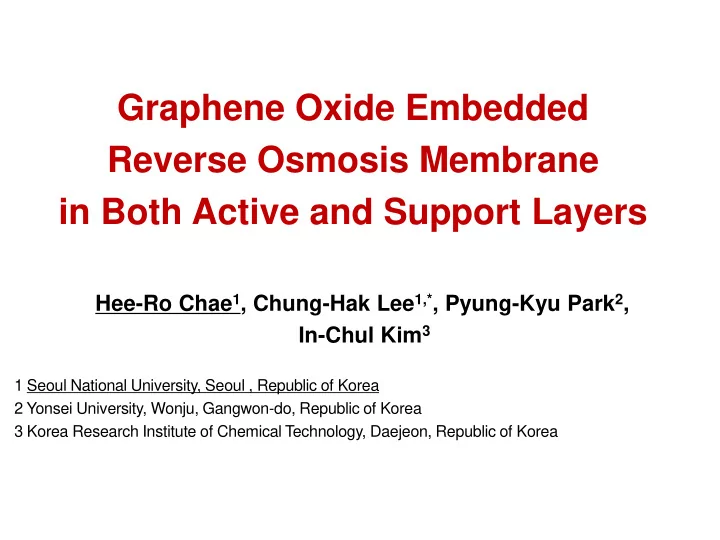

Graphene Oxide Embedded Reverse Osmosis Membrane in Both Active and Support Layers Hee-Ro Chae 1 , Chung-Hak Lee 1,* , Pyung-Kyu Park 2 , In-Chul Kim 3 1 Seoul National University, Seoul , Republic of Korea 2 Yonsei University, Wonju, Gangwon-do, Republic of Korea 3 Korea Research Institute of Chemical Technology, Daejeon, Republic of Korea
Introduction • The key properties of a RO membrane - Water permeability, salt rejection, anti-biofouling, chlorine resistance • Graphene oxide (GO) : Numerous hydrophilic & negatively charged functional groups • Thin-film composite (TFC) membrane with GO RO: reverse osmosis MPD: m-phenylenediamine 2
Notation • Notation of the TFC membranes TFC membrane with GO embedded in A ctive and/or S upport layers : TFC membrane PA PSf : S -GO-TFC membrane GO : A -GO-TFC membrane GO : AS -GO-TFC membrane GO GO 3
Characterization of the TFC membranes • Most hydrophilic & negatively charged AS-GO-TFC membrane Numerous functional groups of GO TFC S A AS TFC S A AS (n=3) (n=6) 4
Surface roughness of the TFC membranes • Decrease of surface roughness with GO in active layer Increase of surface roughness with GO in support layer (n = 9) TFC S A AS A AS GO Concentration in MPD solution ( ∝ GO Conc. in Active layer) 5
Water permeability of the TFC membranes (n = 3) - Higher GO- affinity of the GO -support layer Higher dispersity of GO in active layer Aggregation of GO Hydrophilicity ↑ Roughness ↑ 15.5 bar 2000 ppm NaCl, 30 min 6
Anti-biofouling of the TFC membranes • CLSM images of the bacteria fouled on membranes S -GO-TFC TFC A -GO-TFC AS -GO-TFC 76 ppm GO in MPD solution Green: bacteria CLSM: confocal laser scanning microscopy Cell attachment test at 37 ℃ , 48 h 7
Anti-biofouling of the TFC membranes (n = 9) Hydrophilicity Hydrophobic-hydrophobic interaction ↓ Negative surface zeta potential Net negatively charged bacteria surface Electrostatic repulsion ↑ TFC S A AS 8
Chlorine Resistance of the TFC membranes (n = 3) 2000 ppm NaCl, 15.5 bar 2000 ppm NaCl, 15.5 bar 5000 ppm NaOCl, 16 h 1 30 min 30 min 1 Only GO in active layer was effective for chlorine resistance Before Hydrogen bonding between GO and PA Impeding replacement of After amidic hydrogen with chlorine GO nanosheets Barrier against chlorine for underlying PA In active layer TFC S A AS 0 9
Acknowledgment This research was supported by the Technology Development Program to Solve Climate Changes of the National Research Foundation (NRF) funded by the Ministry of Science, ICT & Future Planning (NRF-2010-0029075) and the Convergence Technology Program funded by Korea Ministry of Environment (2015001640001). 10
Thank you for your attention!
Recommend
More recommend